Gain electrons - Study guides, Class notes & Summaries
Looking for the best study guides, study notes and summaries about Gain electrons? On this page you'll find 2113 study documents about Gain electrons.
Page 3 out of 2.113 results
Sort by
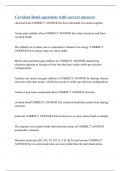
-
Covalent Bond questions with correct answers
- Exam (elaborations) • 17 pages • 2023
-
- $14.99
- + learn more
chemical bond CORRECT ANSWER the force that holds two atoms together Atoms gain stability when CORRECT ANSWER they share electrons and form covalent bonds. The stability of an atom, ion or compound is related to its energy: CORRECT ANSWER lower energy states are more stable Metals and nonmetals gain stability by CORRECT ANSWER transferring electrons (gaining or losing) to form ions that have stable noble-gas electron configurations. Another way atoms can gain stability is CORRECT ANS...
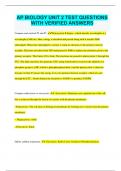
-
AP BIOLOGY UNIT 2 TEST QUESTIONS WITH VERIFIED ANSWERS
- Exam (elaborations) • 18 pages • 2024
- Available in package deal
-
- $9.99
- + learn more
AP BIOLOGY UNIT 2 TEST QUESTIONS WITH VERIFIED ANSWERS Compare and contrast P2 and P1. Photosystem II begins , which absorbs wavelengths at a wavelength of 680 nm. Here, energy is absorbed and passed along until it reaches P680 chlorophyll. When this chlorophyll is excited, it sends its electrons to the primary electron acceptor. Electrons are taken from H2O and passed to P680 to replace the electrons given to the primary acceptor. This forces O2 to form. The electrons are passed to ph...
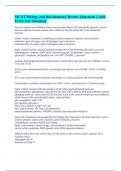
-
MCAT Biology and Biochemistry Review Questions || with Error-free Solutions.
- Exam (elaborations) • 22 pages • 2024
-
- $12.59
- + learn more
How do catalysts and inhibitors affect reaction rates? How is ∆G affected by enzymes? correct answers catalysts increase reaction rates; inhibitors decrease them. ∆G is not affected by enzymes Name 3 ways to determine if something has been oxidized or reduced. correct answers oxidation= gain of oxygen, loss of hydrogen, loss of electrons reduction=loss of oxygen, gain of hydrogen, gain of electrons Name cellular location and end products per glucose for the following: glycolysis, pyru...
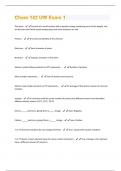
-
Chem 142 UW Exam 1 All Possible Questions and Answers with complete solution
- Exam (elaborations) • 13 pages • 2024
- Available in package deal
-
- $10.19
- + learn more
The atom - Consists of a small nucleus with a positive charge containing most of the weight. Has an electron cloud with mostly empty space but some electrons as well Protons - The chemical identity of the element Electrons - Ionic character of atom Neutrons - Isotopic character of the atom Atomic number (Above element on PT) represents... - Number of protons Mass number represents... - Sum of protons and neutrons Atomic mass (Under element on PT) represents... - An average of the atomic m...

-
HESI A2 ENTRANCE EXAM: READING COMPREHENSION, CHEMISTRY, GRAMMAR, BIOLOGY, VOCABULARY & GENERAL KNOWLEDGE, CRITICAL THINKING, ANATOMY & PHYSIOLOGY AND MATH
- Exam (elaborations) • 81 pages • 2024 Popular
-
- $8.99
- 3x sold
- + learn more
HESI A2 ENTRANCE EXAM: READING COMPREHENSION, CHEMISTRY, GRAMMAR, BIOLOGY, VOCABULARY & GENERAL KNOWLEDGE, CRITICAL THINKING, ANATOMY & PHYSIOLOGY AND MATH VERSION 2 (With answers) Reading Comprehension Neurologists and biological psychologists have witnessed a sharp increase in the knowledge and understanding of particular structures of the brain over the past two decades. As technology becomes ever more advanced, scientists are able to isolate the functions of even small regions of ...
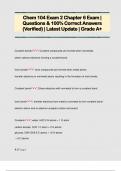
-
Chem 104 Exam 2 Chapter 6 Exam | Questions & 100% Correct Answers (Verified) | Latest Update | Grade A+
- Exam (elaborations) • 20 pages • 2024
-
- $11.49
- + learn more
Covalent bonds: Covalent compounds are formed when nonmetals share valence electrons forming a covalent bond. Ionic bonds: Ionic compounds are formed when metal atoms transfer electrons to nonmetal atoms resulting in the formation of ionic bonds. Covalent bond: Share electrons with nonmetal to form a covalent bond Ionic bond: transfer electrons from metal to nonmetal to form covalent bond - electron donor and an electron acceptor (cation and anion) Covalent: water, H2O 2 H atoms + 1 O ato...
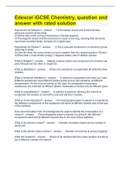
-
Edexcel iGCSE Chemistry, question and answer with rated solution
- Exam (elaborations) • 29 pages • 2023
- Available in package deal
-
- $20.49
- 1x sold
- + learn more
Edexcel iGCSE Chemistry, question and answer with rated solution Experiment for Diffusion? 1) HCl placed at one end of the test tube, ammonia solution at the other. 2) Where they meet, a ring of Ammonium Chloride appears. 3) The diagram shows that the ammonia is closer to the ring, showing that ammonia must have travelled faster, showing it's a lighter gas. Experiment for Dilution? 1) Put a coloured substance in a solvent e.g food colouring in water. 2) Over the time, the colour le...
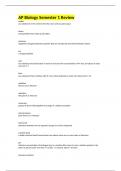
-
AP Biology Semester 1 Review
- Exam (elaborations) • 19 pages • 2024
-
- $13.89
- + learn more
AP Biology Semester 1 Review matter any substance in the universe that has mass and occupies space atoms small particles that make up all matter electrons negatively charged subatomic particles that are transferred and shared between atoms ion a charged particle acid any substance that dissociates in water to increase the concentration of H+ ions; pH values of acids are from 1-7 base any substance that combines with H+ ions when dissolved in water; pH values from ...
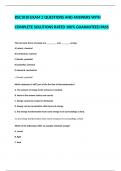
-
BSC1010 EXAM 2 QUESTIONS AND ANSWERS WITH COMPLETE SOLUTIONS RATED 100% GUARANTEED PASS
- Exam (elaborations) • 42 pages • 2024
- Available in package deal
-
- $11.49
- + learn more
BSC1010 EXAM 2 QUESTIONS AND ANSWERS WITH COMPLETE SOLUTIONS RATED 100% GUARANTEED PASS The two basic forms of energy are _________ and ________ energy. A) caloric, chemical B) mechanical, material C) kinetic, potential D) potential, chemical E) chemical, mechanical c.) kinetic, potential Which statement is NOT part of the first law of thermodynamics? A. The amount of energy in the universe is constant. B. None of the answer choices are correct. C. Energy cannot be created or destro...
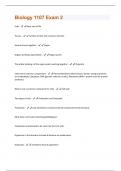
-
Biology 1107 Exam 2 Questions and Answers 100% Solved correctly
- Exam (elaborations) • 26 pages • 2024
- Available in package deal
-
- $7.99
- + learn more
Cells - Basic unit of life Tissues - Cambos of cells with common function Several tissues together - Organ Organs working cooperatively - Organ system The whole shebang, all the organ system working together - Organism Cells have 4 common components - Plasma Membrane (fluid mosaic, Barrier, intergral proteins are embedded), Cytoplasm, DNA (genetic material of cells), Ribosomes (RNA + protein used for protein synthesis) What is not a common component for Cells - Cell wall Two types of ce...

That summary you just bought made someone very happy. Also get paid weekly? Sell your study resources on Stuvia! Discover all about earning on Stuvia


